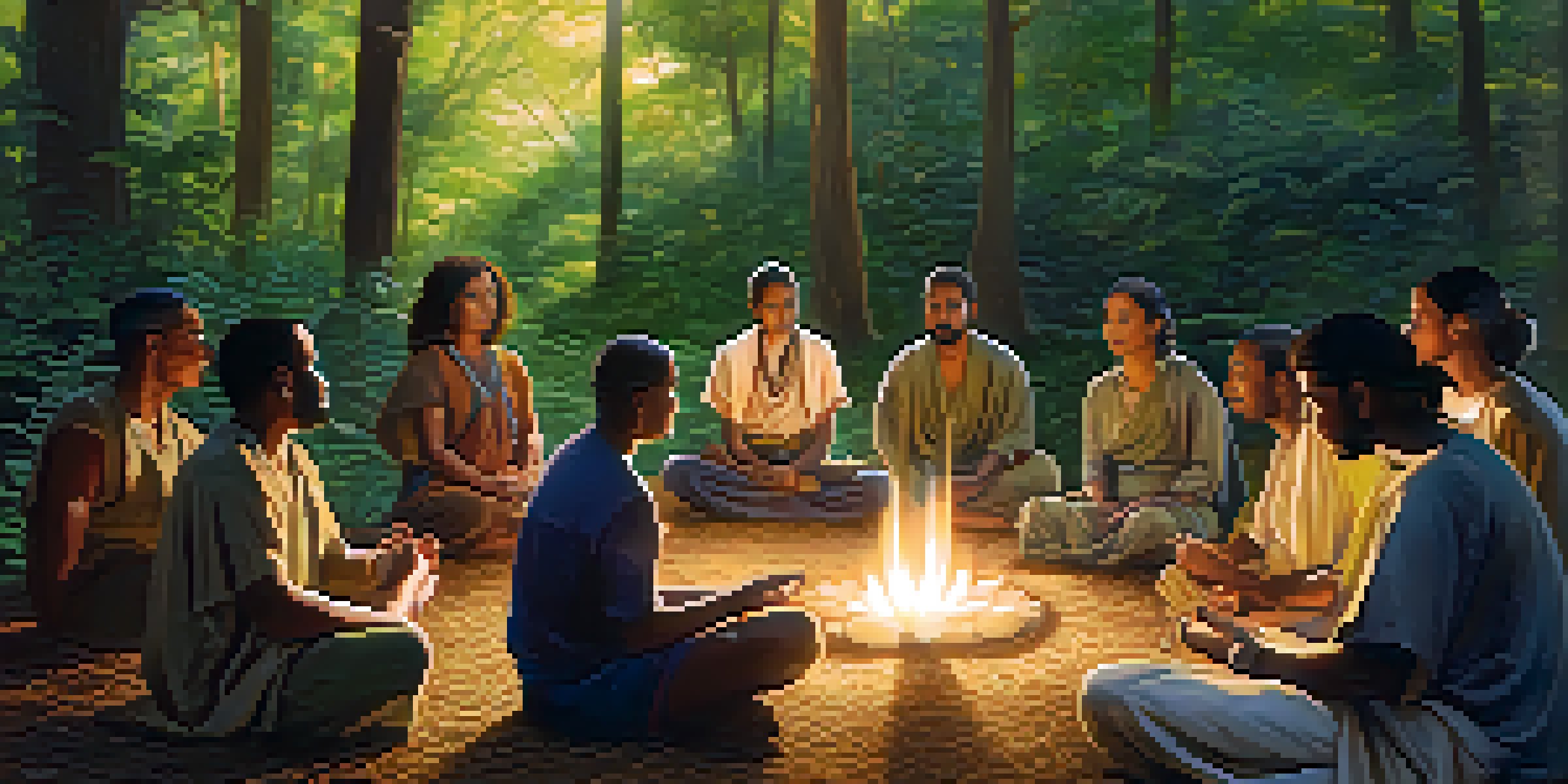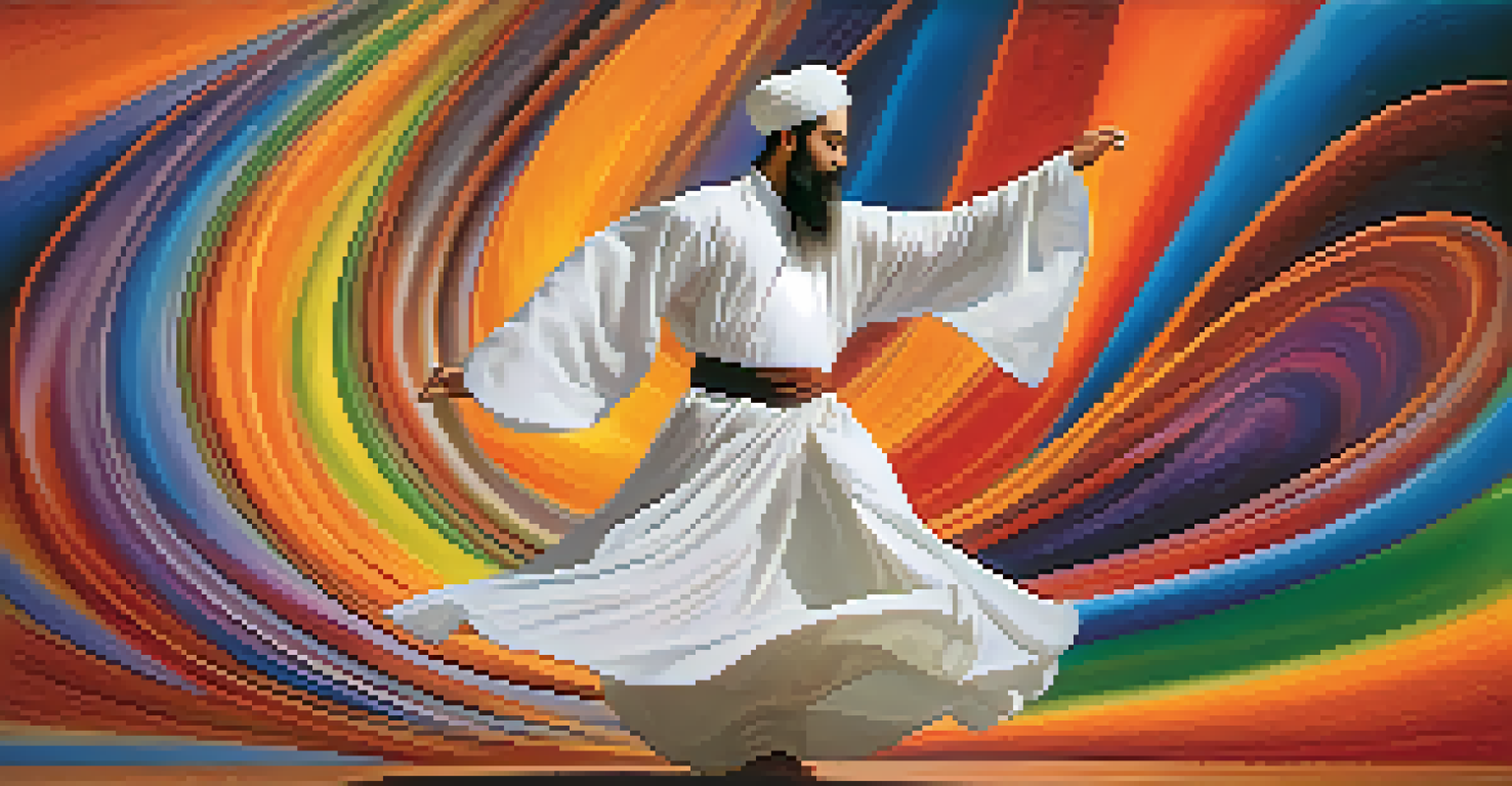Music Genres in Spirituality: From Hymns to Chanting

The Role of Music in Spiritual Practices Across Cultures
Music has been an integral part of spiritual practices for centuries, transcending cultures and beliefs. From ancient rituals to modern worship, melodies and rhythms have the power to connect individuals to the divine. This emotional connection can enhance feelings of community, devotion, and inner peace, making music a universal language of spirituality.
Music is the shorthand of emotion.
In many cultures, music serves as a medium for storytelling, passing down sacred traditions and teachings through generations. For instance, Indigenous tribes often use drumming to invoke spirits or celebrate important life events. This highlights how music not only enriches spiritual experiences but also preserves cultural heritage.
As we dive deeper into the relationship between music and spirituality, we’ll explore specific genres that have evolved over time, each serving unique purposes and resonating deeply with practitioners. From hymns in churches to the calming strains of chanting, each genre offers a different pathway to spiritual connection.
Hymns: The Heartfelt Expression of Faith
Hymns are often seen as the backbone of many religious ceremonies, especially in Christianity. These melodic pieces express devotion, praise, and gratitude, allowing congregations to come together in unified worship. The lyrics often reflect deep theological concepts, making them not just songs but also teaching tools.

For example, traditional hymns like 'Amazing Grace' resonate with themes of redemption and hope, encouraging believers to reflect on their spiritual journeys. The communal singing of hymns fosters a sense of belonging and collective faith, creating a powerful atmosphere during worship services.
Music Unites Spiritual Practices
Across cultures, music serves as a universal language that enhances spiritual connections and community bonding.
Moreover, the evolution of hymns has led to contemporary genres that blend traditional melodies with modern themes. This fusion keeps the spirit of hymns alive, appealing to new generations while maintaining their core message of faith and connection to the divine.
Chanting: A Meditative Journey Through Sound
Chanting is a spiritual practice that spans various religions, from Buddhism to Hinduism, and even in some Christian traditions. This repetitive vocalization of phrases or mantras creates a meditative state, helping practitioners focus and connect with their inner selves. The rhythmic nature of chanting can induce a sense of calm and presence, making it a powerful spiritual tool.
Where words fail, music speaks.
One famous example is the 'Om' chant in Hindu practices, believed to represent the sound of the universe. This single syllable encapsulates profound philosophical ideas and is used in meditation to align the body and mind with spiritual energy. Such practices illustrate how chanting serves as both a form of worship and a personal journey of self-discovery.
As we explore further, chanting has also found its way into modern spiritual practices, often incorporating elements from various traditions. This blend not only enriches the experience but also reflects a growing desire for inclusivity in spiritual communities.
World Music Influences in Spiritual Practices
The global landscape of spirituality is rich and diverse, as seen in the music that accompanies various practices. From African drumming to Native American flutes, world music brings a unique flavor to spiritual experiences. These genres often incorporate instruments and rhythms that resonate deeply within their cultural contexts.
For instance, the use of the djembe drum in West African spiritual ceremonies serves to summon spirits and foster community bonding. Each beat carries historical significance, connecting participants to their ancestors and cultural heritage. This illustrates the profound impact of world music on spirituality and its ability to convey messages that transcend spoken language.
Hymns and Chanting Foster Reflection
Hymns and chanting provide heartfelt expressions of faith, facilitating personal reflection and collective worship.
As we witness a growing interest in global spirituality, many practitioners are blending these musical influences into their own spiritual practices. This fusion not only enriches individual experiences but also promotes understanding and appreciation of different cultures within spiritual communities.
Gregorian Chant: The Sound of Sacred Tradition
Gregorian chant, a form of plainchant, holds a special place in the history of Western spirituality. Originating in the early medieval church, these unaccompanied sacred songs were designed to enhance the liturgical experience, fostering a transcendent atmosphere. The smooth, flowing melodies allow worshippers to engage deeply with the text, often derived from scripture.
What sets Gregorian chant apart is its use of modal scales, giving it a distinctive sound that evokes a sense of reverence and contemplation. This style of music invites listeners into a meditative state, making it ideal for prayer and reflection. Many modern spiritual practices still incorporate elements of this ancient tradition, showcasing its lasting impact on contemporary spirituality.
Today, Gregorian chant has seen a revival in interest, with many artists and choirs reinterpreting these timeless pieces. This resurgence not only honors the tradition but also introduces new audiences to the beauty and depth of this sacred music.
Sufi Music: The Dance of Devotion and Ecstasy
Sufi music, particularly the whirling dervishes' performances, is a captivating blend of spiritual practice and artistic expression. Rooted in Islamic mysticism, this genre aims to evoke a state of divine connection through rhythm and movement. The repetitive nature of the music, often accompanied by poetry, facilitates a trance-like state that allows participants to transcend worldly concerns.
One of the most renowned forms of Sufi music is Qawwali, characterized by its passionate vocal performances and vibrant instrumentation. This genre not only celebrates love and devotion to God but also encourages communal participation, inviting listeners to join in the ecstatic experience. The communal aspect of Sufi music fosters unity and deep connections among participants.
Modern Music Bridges Tradition
Today's spiritual music blends traditional elements with contemporary influences, making spirituality more accessible to diverse audiences.
As Sufi music gains popularity worldwide, it continues to inspire individuals on their spiritual journeys. The blend of sound, movement, and poetry offers a unique pathway to experience the divine, resonating with those seeking a deeper connection to their spirituality.
Modern Spiritual Music: Bridging Tradition and Innovation
In today's spiritual landscape, modern music genres are evolving to reflect contemporary beliefs and experiences. Artists are fusing elements from various traditions to create new sounds that resonate with a diverse audience. This blending not only honors traditional practices but also speaks to the unique spiritual journeys of individuals in a modern context.
For example, the rise of yoga music incorporates ambient sounds, chants, and contemporary melodies, creating an atmosphere conducive to relaxation and mindfulness. These modern genres often draw from various cultural influences, offering listeners an inclusive way to engage with spirituality. This approach makes spiritual music more accessible and relatable for a broader audience.

As we continue to explore this dynamic intersection of music and spirituality, it's clear that artists play a vital role in shaping the future of spiritual expression. By embracing innovation while honoring tradition, modern spiritual music invites individuals to explore their paths in a way that resonates with their personal beliefs.